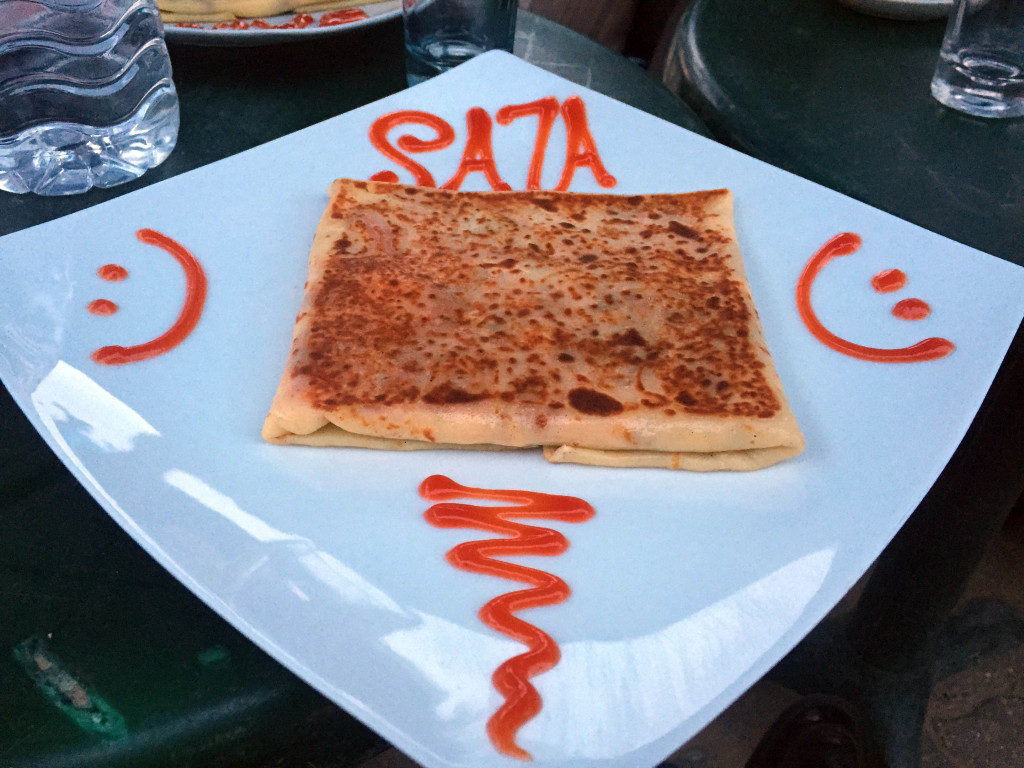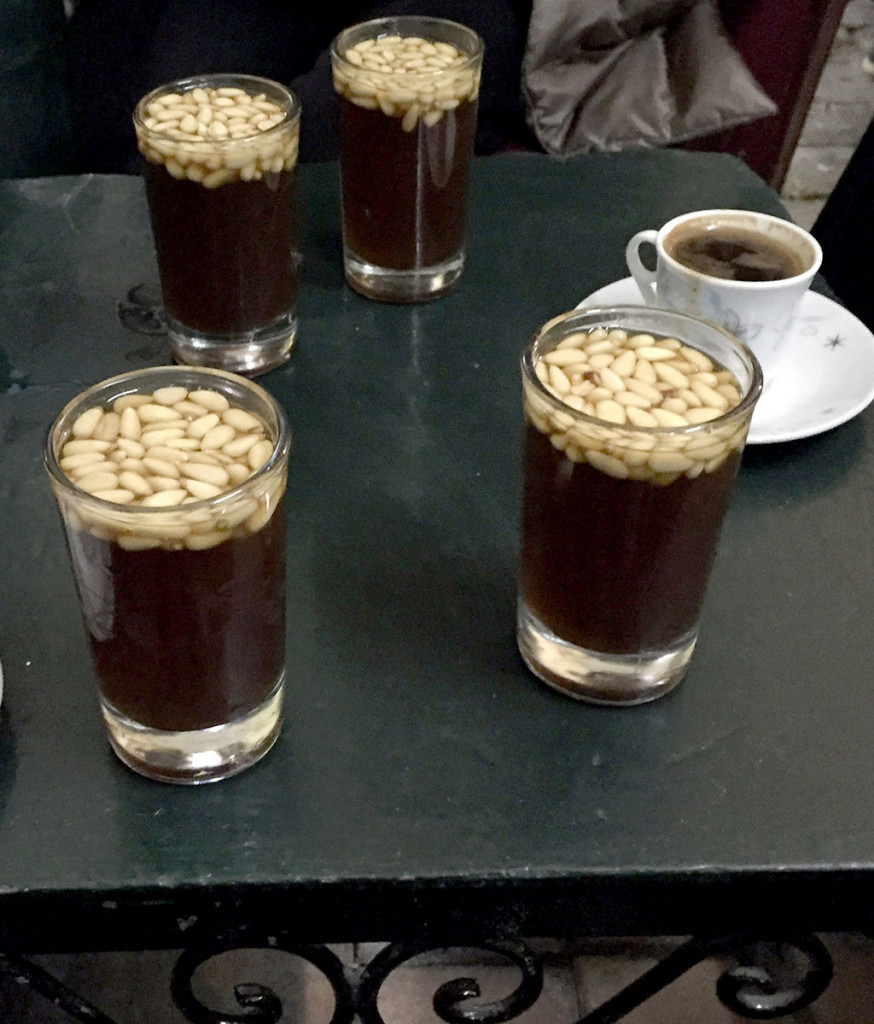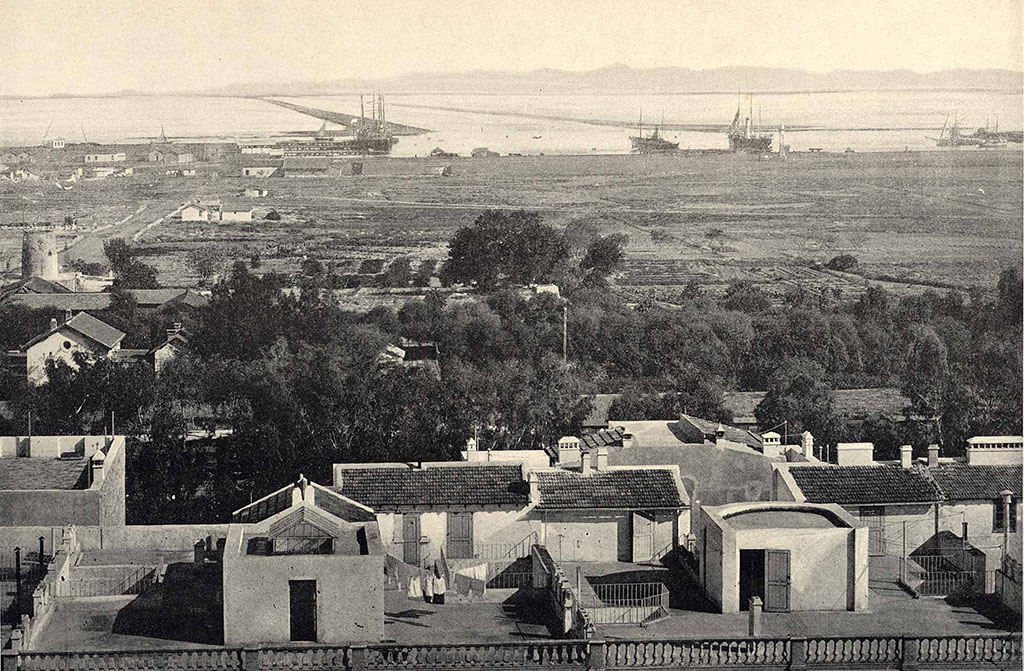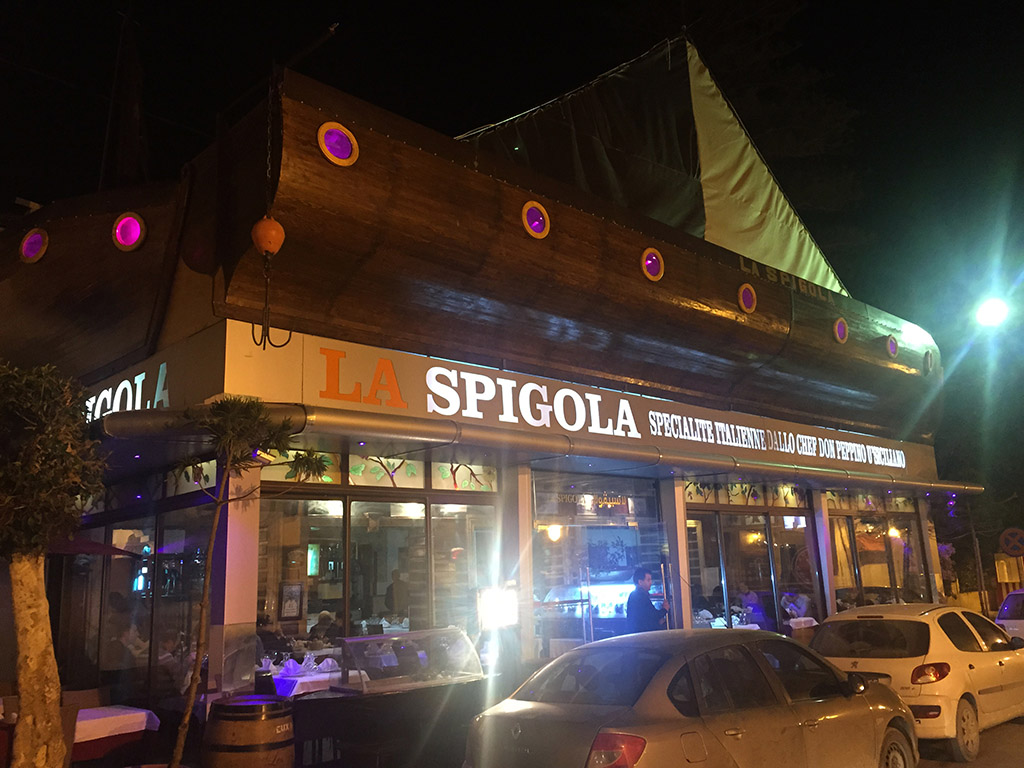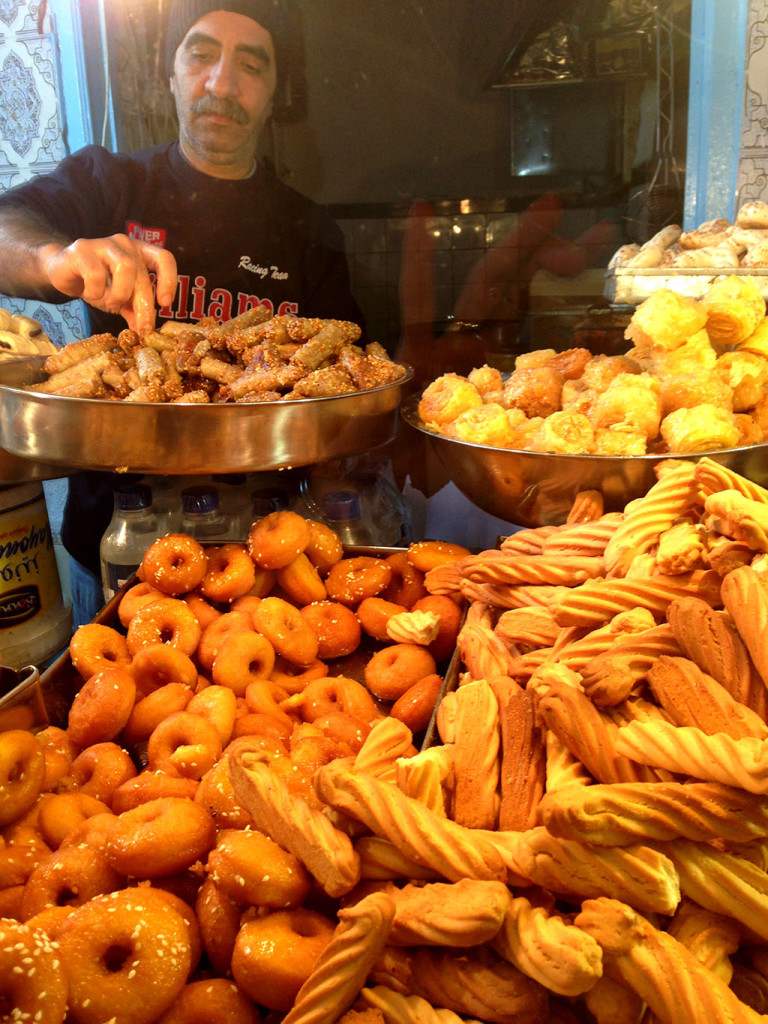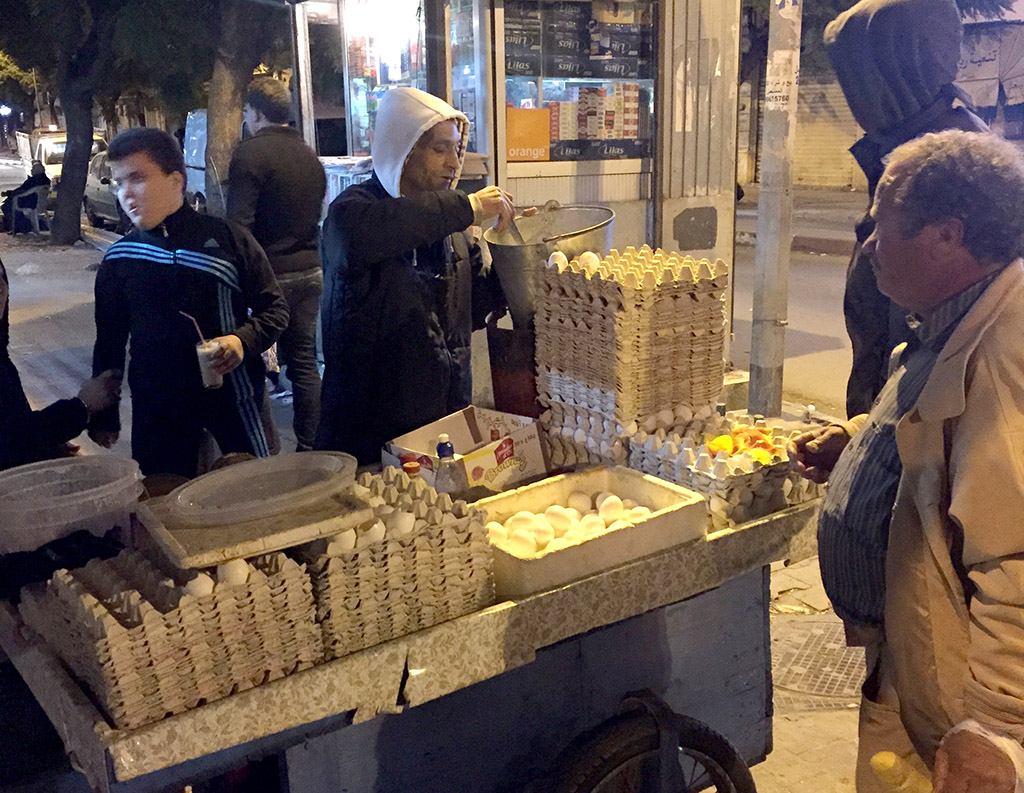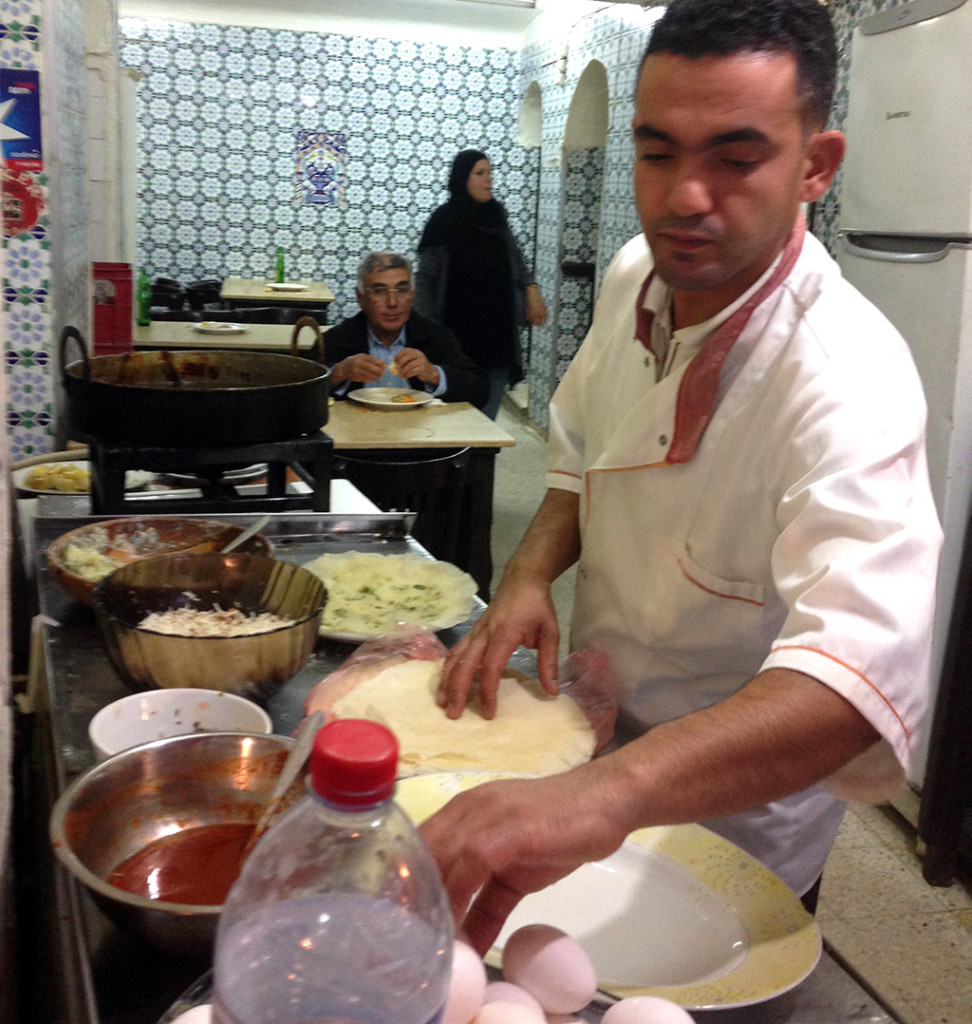In Halq al-Wādī there is “La Marine” Cafè where – despite of the long waiting times – you can enjoy tasteful tuna and cheese crepês sitting on those tiny tables facing one of the most picturesque waterfronts of the Northern Africa, that once was the enchanting scenario of Punic wars.
While sipping fragrant tea enriched with pine nuts, it’s unavoidable to start visualizing those images evoked by the plethoric letters of Celio Antipatro and Polibio that described the war between Rome and Carthage. Pine nuts donate all their intense woodland scent to the warm herbal infusion, thus creating a perfect bond (do not trust Asian pine nuts; although they are rounder and juicier, they do not own that unmistakable aroma).
Tuna and cheese crêpes, Cafè “La Marine” Tunis, La Goulette (2014).
Pine nuts tea, Tunis, Medina (2014).
La Goulette is one of the 19 zones of Grand Tunis, the most densely populated metropolis of Tunisia with almost two and a half million of citizens. La Goulette, built up around the canal that connects the lagoon to the sea, has hosted the most prominent Italian community that settled in Tunis. In 1865, during the French protectorate, the family Fasciotti-Gnecco of Italian origin received, for free, a swamp at the borderline with the sea. In exchange, the family promised to reclaim the humid lands and manage discharge of wastewater. Mrs Carlotta Gnecco herself busily made discharged wagons and wagons of debris to fill swamplands, thus retrieving little by little a residential zoning. The Lady, Genovese of origin, had already planned in the smallest details a program of property speculation at high profitability.
Tunis, sightseeing of “La Petite Sicile” with the place where the port of Tunis will be constructed, on the background (1890 ca).
During reclamation, the family rented lands for a nominal fee – yet never for free! – also allowing building of small unstable houses. In 1893, the construction of the port of Tunis attracted in La Goulette numerous traders: dockworkers and small merchants settled here, in particular mechanics and auto parts dealers, of Sardinian and Sicilian origin. To the precariousness of houses also corresponded a disordered urban design. The landscape that thus originated was extraordinarily similar to landscapes that can be found in the Sicilian coasts, in proximity of ports, of small towns and fisherman’s villages. The neighborhood was symbolically named Petite Sicile, as Sicily mirrored herself in these spontaneous forms of architecture, in the thick intertwining of houses and social relationships, in the way of living “in the streets” of children and, of course, in the food.
A scene from the film “Un été à La Goulette”, Fédir Boughedir, French-Belgian-Tunisian production, 1996.
Fédir Boughedir tinted a painting of extraordinary vivacity that portrays this peculiar enclave which relives its summer colors, the sounds of popular festivals and the private atmospheres in Un été à La Goulette (1996). In the movie, shoot in the background the real life of a maritime village, among bags of cacahuètes, brick and pasta, three idioms intertwine with extreme familiarity: characters lovably talk French, lighten the tone of their conversations in Arabic and end up swearing in Sicilian!
An unwritten law forbids gourmet traveler friends to search restaurant typical of their own country when traveling abroad, even in severe cases of abstinence from spaghetti or coffee. The case of the Petite Sicile is, instead, an authentic exception: the so-called “Italian restaurant” is not a pale glare of a great gastronomic tradition reinterpreted in the local ‘sauce’; rather it represents a more authentic expression of a culture that successfully settled deeply grounding its roots in a brand new soil. The excellence of Sicilian gastronomy triumphs in the magnificent grilled breams and in the sauté of mussels and crustaceans, in citrus fruit sorbets and in the fine patisserie. La Petite Sicile is a sequence of restaurants, the majority and, above all, the most sophisticated of which do not hide their Sicilian origins. An example is La Spigola, the restaurant – with a boat on “top” – that belongs to Don Peppino U’ Siciliano.
“LA SPIGOLA. SPECIALITE ITALIENNE DALLO CHEF DON PEPPINO U’ SICILIANO”, one of the numerous Italian restaurants of Sicilian origins in the neighborhood, Tunisi, “La Petite Sicile” (2014).
Street food in Tunis is a rich and merry contamination of berber, semitic and western components. It is just literally impossible to resist to: on the one hand, inside the Medina a multitude of stands vainly showing off sweet and savory fried food, spices, scents and coffee vibrantly run after the other, temptation lurking in every corner, to the point of making you succumb to divine indulgence. On the other hand, in the City, every ground floor, every arcade, every corner becomes a place that offers you food: caramelized dried fruit, boiled eggs, crêpes and Arabian sandwiches.
Sweet seller, Medina, Tunisi (2014).
Boiled eggs peddler, Tunis (2014).
The brick is undoubtedly the main dish of Tunisian cooking, always present not only in the menus of all restaurants, but also anywhere you can light up fire underneath a frying pan. Fragrant and super delicious street food, the brick is a very thin filo pastry that hedges in few and simple ingredients: boiled potatoes, tuna fish, cheese, parsley. The detail that renders this recipe a work of art is in the egg, added raw at the last minute, right before wrapping the filo in the shape of a half moon. The brick is let to dive in extremely hot boiling oil, where skillful hands will make it fry long enough to leave the egg yolk runny. As result, the yolk will languidly flow out the precious parcel leaving you utterly mouthwatering.
“Brick” preparation, Medina, Tunis (2014).
The most important thing to obtain the perfect brick is dexterity and manual ability in the frying procedure. Same skills are indispensable for cooking kafteji, a work of art in street food. You can find it in the Medina, cooked express to the sound of music, where music is not just a sequence of notes in the background; rather is a melody composed by the sound of knives hitting steel crockery, by the oil crackling while frying and by the rhythmic dancing of the cook who is cooking kafteji for you on demand. To cook this sandwich are therefore requested agility, a rooted sense of rhythm and a particular joie de vivre. Kafteji filling is made of: diced tomatoes, peppers and yellow pumpkins, zucchini sliced in circles, potato sticks and bull’s eye eggs to be pan-fried separately in crackly oil, thus triggering the magic of oriental flavors with a mix of spices, harissa, garlic, parsley. With two long sharp opposing knives or two steel palettes, ingredients are cut with crisscrossing movements; then tomato sauce is added and finally bread is filled. And remember to give back to the sandwich that part of crumb that had been previously removed to make room for the filling, without having first used it to pick up all the leftovers from ingredients and sauces.
No cured meats, no hydrogenated fats, no preservative, no additives or colorants and, above all, no leftovers!
Translation by Ester Badami
Download VIDEO
“Kafteji” preparation, Medina, Tunis (2014), M. Carta production.
La nostra Africa Mediterranea
Al Cafè “La Marine” ad Halq al-Wādī – con la dovuta pazienza per i tempi del servizio – ai tavolini aperti su uno dei più suggestivi lungomare dell’Africa settentrionale, incantevole scenario delle sanguinose guerre puniche, si possono gustare delle ottime crêpes salate al tonno e formaggio.
Ritornano alla mente le immagini evocate dalle doviziose note di Celio Antipatro e Polibio sullo scontro tra Roma e Cartagine, visioni accompagnate dalla fragranza del tè con i pinoli, connubio ideale con la calda infusione alla quale i semi regalano tutto il loro inteso profumo silvestre (diffidate dei pinoli di provenienza asiatica, più tondeggianti e polposi, ma privi di quell’inconfondibile aroma).
Crêpe salata al tonno e formaggio del Cafè “La Marine”, Tunisi, La Goulette (2014).
Tè con pinoli, Tunisi, Medina (2014).
Vi trovate a La Goulette, una delle 19 zone che oggi compongono la Grand Tunis, la metropoli più popolosa della Tunisia con i suoi quasi due milioni e mezzo di abitanti. La frazione de La Goulette, sorta attorno al canale che collega la laguna al mare, ha ospitato la più cospicua comunità italiana insediatasi presso Tunisi: durante il protettorato francese la famiglia di origini italiane Fasciotti-Gnecco ricevette nel 1865, a titolo gratuito, questa fascia paludosa di confine con il mare con l’impegno di bonificare le zone umide e gestire il deflusso delle acque reflue. Fu la stessa signora Carlotta Gnecco a far scaricare alacremente carretti su carretti di detriti con i quali colmare i terreni paludosi, recuperando palmo a palmo terreno edificabile sul quale la signora, di origini genovesi, aveva già definito nei minimi dettagli un programma di speculazione edilizia ad alta redditività.
Tunisi, panoramica de “La Petite Sicile” con, in fondo, il sito sul quale sorgerà il porto di Tunisi (1890 ca).
Nelle more della bonifica, la famiglia concesse a prezzi simbolici – mai gratuitamente! – l’affitto dei terreni, consentendo anche la costruzione di piccole abitazioni di natura precaria. Nel 1893 l’avvio della costruzione del porto di Tunisi attrae a La Goulette numerose attività commerciali: cominciano a stanziarsi nell’area lavoratori portuali e piccoli commercianti, in particolare meccanici e rivenditori di ricambi per automobili, di provenienza sarda e siciliana. Alla precarietà delle abitazioni corrisponde anche un disordinato disegno del tessuto urbano. Il paesaggio che ne deriva è straordinariamente simile ai paesaggi che si trovano lungo le sponde della Sicilia, in prossimità dei porti, dei centri minori o dei borghi pescherecci; significativamente la borgata ha preso il nome di Petite Sicile, dove la Sicilia si rispecchia nelle architetture spontanee, nei tessuti fitti di case e di relazioni sociali, nel modo di vivere “per strada” dei bambini, e, ovviamente, nel cibo.
Scena del film “Un été à La Goulette”, Fédir Boughedir, produzione franco-belga-tunisina, 1996.
Fédir Boughedir tinteggia un quadro di straordinaria vivacità di questa particolarissima enclave che rivive con i suoi colori estivi, i suoni delle feste popolari, le atmosfere private in Un été à La Goulette (1996); nel film, sullo sfondo della vita reale della borgata marinara, tra coppi di cacahuètes, brick e piatti di pasta, con straordinaria familiarità si intrecciano tre lingue: i protagonisti dialogano amabilmente in francese, accendono i toni delle loro conversazioni in arabo e finiscono con l’imprecare in siciliano!
Esiste una legge non scritta che impedisce agli amici viaggiatori gourmet di cercare ristoranti della propria nazione quando si è all’estero, anche in gravi casi di astinenza da spaghetti o caffè. Il caso della Petite Sicile è, invece, un’autentica eccezione: qui il “ristorante italiano” non è il pallido riflesso di una grande tradizione gastronomica reinterpretata in salsa locale, ma l’espressione più autentica di una cultura che è riuscita con successo a trapiantarsi affondando le proprie radici in un terreno nuovo. L’eccellenza della gastronomia siciliana trionfa nelle magnifiche orate alla griglia e nei sautè di mitili e crostacei, nei sorbetti agli agrumi e nella raffinata pasticceria. Qui è tutto un susseguirsi di ristoranti, di cui i più numerosi, ma soprattutto i più raffinati, non dissimulano le loro origini siciliane, come La Spigola, il ristorante – con “sopra” una barca a vela – di Don Peppino U’ Siciliano.
“LA SPIGOLA. SPECIALITE ITALIENNE DALLO CHEF DON PEPPINO U’ SICILIANO”, uno dei numerosi ristoranti di origine siciliana presenti nel quartiere, Tunisi, “La Petite Sicile” (2014).
Anche lo street food di Tunisi è una ricca e festosa contaminazione di componenti berbere, semite e occidentali. È letteralmente impossibile da evitare: non solo all’interno della Medina i banchi delle fritture dolci e salate, di forni e fornelli, di spezie, profumi e caffè si rincorrono ritmicamente tentandoti ad ogni angolo fino a farti capitolare perché non ce la fai più a resistere. Ma anche per la città, ogni piano terra, ogni porticato, ogni angolo è un luogo che ti offre del cibo: frutta secca caramellata, uova sode, crêpes e pani arabi.
Venditore di dolci dentro la Medina, Tunisi (2014).
Venditore ambulante di uova sode, Tunisi (2014).
Il brick è il padrone indiscusso della scena culinaria tunisina, sempre presente sia sui menù dei ristoranti, sia ovunque sia possibile accendere un fuoco sotto una padella. Fragrante e buonissimo mangiato in strada, raccoglie dentro una sottilissima sfoglia di acqua e farina pochi semplici ingredienti: patate lesse, tonno, formaggio, prezzemolo. Il dettaglio che fa di questa preparazione un capolavoro è l’uovo, aggiunto crudo per ultimo prima di richiudere a mezzaluna la sfoglia e tuffarla in olio profondo bollente, dove mani sapienti sapranno farlo friggere quel tanto che basta a lasciare che il tuorlo rimanga sufficientemente liquido da fuoriuscire languidamente al momento del servizio.
Preparazione del “brick” dentro la Medina, Tunisi (2014).
Quel che più conta per un ottimo brick è la manualità e l’abilità in cottura. Doti più che mai indispensabili per preparare il kafteji, un capolavoro dello street food. Lo si può trovare nella Medina cucinato espresso a suon di musica, dove la musica non è una base di accompagnamento esterna all’atto di cucinare, ma una melodia che si compone dei suoni dei coltelli sulle stoviglie di alluminio, del crepitare dell’olio in frittura e della danza ritmata del cuoco che ve lo sta preparando on demand. Sono pertanto richieste agilità, senso del ritmo e una particolare joie de vivre per la preparazione di questo panino, la cui farcia è composta da tocchetti di pomodoro, peperone e zucca gialla, rondelle di zucchine, bastoncini di patate e uova all’occhio di bue da saltare separatamente in olio vivace, innescando la magia dei sapori orientali con un sapiente mix di spezie, harissa, aglio, prezzemolo e pepe. Dopo aver fritto ogni ingrediente, si assembla il tutto in una bastardella a bordi alti e, con due lunghi coltelli affilati contrapposti o due palette di acciaio, si tranciano gli ingredienti con movimenti contrapposti; si aggiunge la salsa di pomodoro e si farcisce il pane, ricordandosi di restituire al pane quella manciata di mollica scavata per far posto alla farcia dopo averla debitamente utilizzata per raccogliere dalla bastardella i sughi residui di tutti gli ingredienti.
Niente insaccati, grassi idrogenati, conservanti né coloranti e, soprattutto, nessuno scarto!
Download VIDEO
Preparazione del “kafteji”, Medina, Tunisi (2014), video di M. Carta.
Head Image: Dolci, Tunisi.
